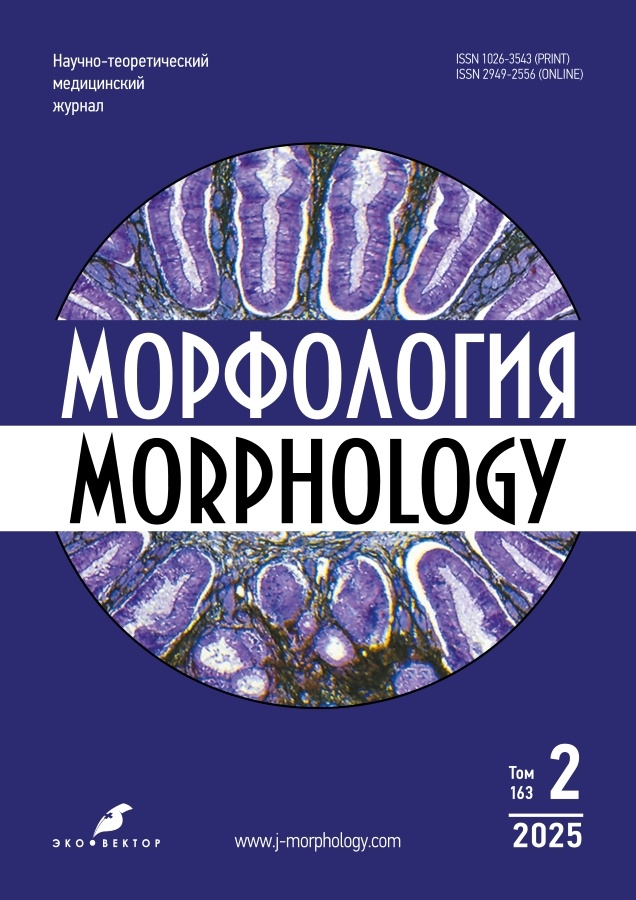Histogenetic Features of Anorectal Lining Formation in Rats During Embryogenesis
- Authors: Komarova A.S.1, Slutskaya D.R.1
-
Affiliations:
- Kirov Military Medical Academy
- Issue: Vol 163, No 2 (2025)
- Pages: 115-122
- Section: Original Study Articles
- URL: https://bakhtiniada.ru/1026-3543/article/view/312121
- DOI: https://doi.org/10.17816/morph.656311
- EDN: https://elibrary.ru/ICUQNX
- ID: 312121
Cite item
Abstract
BACKGROUND: During embryonic development, the formation and differentiation of the mucosal tissues of the anal canal occur through the interaction of epithelia of different germ layer origins—ectodermal and enterodermal. The epithelial lining of the anorectal region of the rectum requires further characterization. Data on the histological structure and formation of tissue components in the anorectal canal during embryogenesis are relevant both theoretically (from an evolutionary perspective) and practically, as this region is a site of embryonic anomalies and neoplasms.
AIM: To describe the histogenetic features of anorectal lining formation in rats during embryogenesis.
METHODS: An observational, single-center, retrospective, uncontrolled study was conducted. The material consisted of the caudal portion of the anorectal canal of laboratory white rat (Rattus norvegicus) embryos at embryonic days 9, 13, 15, and 18. Morphological research methods were used. Histological analysis was performed on hematoxylin and eosin–stained sections.
RESULTS: On embryonic day 9, a cloacal membrane forms in the distal part of the embryo body. By day 13, the anorectal canal is formed and lined by cutaneous and intestinal epithelia, with a bilayered urothelium-like epithelium serving as a transitional interface. By day 15, this bilayered epithelium is replaced by clusters of rounded cells with hyperchromatic nuclei. On day 18, a clearly defined boundary is observed at the anorectal junction between the two genetically and morphologically distinct epithelia.
CONCLUSION: The findings indicate that, during embryogenesis in rats, a transient urothelium-like epithelium of the transitional zone exists between the cutaneous and intestinal segments of the anorectal canal, exhibiting distinct morphofunctional organization. In the later stages of embryogenesis, this transitional epithelium disappears, suggesting its provisional nature.
Full Text
##article.viewOnOriginalSite##About the authors
Anastasia S. Komarova
Kirov Military Medical Academy
Author for correspondence.
Email: tsirya7777777@gmail.com
ORCID iD: 0009-0004-2390-9927
SPIN-code: 6585-6771
Russian Federation, Saint Petersburg
Dina R. Slutskaya
Kirov Military Medical Academy
Email: dina_hanieva@mail.ru
ORCID iD: 0000-0003-3910-2621
SPIN-code: 2546-9393
Cand. Sci. (Biology), Associate Professor
Russian Federation, Saint PetersburgReferences
- Milto IV. Functional human morphology. Vol 1. Viscerology. Moscow: Logosfera; 2022. (In Russ.) ISBN: 9785986570792
- Thomas DFM. The embryology of persistent cloaca and urogenital sinus malformation. Asian J Androl. 2020;22(2):124–128. doi: 10.4103/aja.aja_72_19
- Volkova OV, Pekarskiy MI. Embryogenesis and age-related histology of human internal organs. Moscow: Meditsina; 1976. (In Russ.)
- Qi BQ, Beasley SW, Williams AK, Frizelle FA. Does the urorectal septum fuse with the cloacal membrane? J Urol. 2000;164(6):2070–2072. doi: 10.1016/s0022-5347(05)66969-8
- Odintsova IA, Danilov RK, Komarova AS, Zheglova MYu. Histogenetic basis of the development of the anorectal and utero-vaginal tracts. Morphology. 2018;153(3):207. (In Russ.) doi: 10.17816/morph.409204
- Danilov RK, Komarova AS, Zheglova MYu, Odintsova IA. On the tissue of tissue derivatives of the vertebrate cloaca. In: Questions of morphology of the XXI century: Proceedings of the 26th All-Russian Scientific Conference “Histogenesis, Reactivity and Tissue Regeneration”. St. Petersburg, 16–17 May 2024. Saint Petersburg: Limited liability company “Izdatel’stvo DEAN”, 2024. P. 38–48. EDN: CAJPBP
- Goldberg OA, Kim AD. Structure of the anal canal and distal rectum in Wistar rats. Acta Biomedica Scientifica. 2016;1(4):126–128. doi: 10.12737/22999 EDN: WKNRVB
- Yamaguchi K, Kiyokawa J, Akita K. Developmental processes and ectodermal contribution to the anal canal in mice. Ann Anat. 2008;190(2):119–128. doi: 10.1016/j.aanat.2007.08.001
- Khlopin NG. General biological and experimental foundations of histology. Moscow: Izdatel’stvo Akademii Nauk SSSR; 1946. (In Russ.)
- Knorre АG. Embryonic histogenesis: morphological essays. Moscow: URSS; 2023. (In Russ.)
- Tschopp P, Sherratt E, Sanger TJ, et al. A relative shift in cloacal location repositions external genitalia in amniote evolution. Nature. 2014;516(7531):391–394. doi: 10.1038/nature13819
- Solovyov GS, Yanin VL, Panteleev SM, et al. Morphogenesis problem and presumption of providence. In: Questions of morphology of the XXI century: Proceedings of the 25th All-Russian Scientific Conference “Histogenesis, Reactivity and Tissue Regeneration”. St Petersburg, 13–14 May 2021. Saint Petersburg: Limited liability company «Izdatel’stvo DEAN», 2021. P. 62–74. EDN: QYFOBH
- Shevlyuk NN. The main patterns of transformation of the organs of the reproductive system during the evolution of vertebrates. Journal of Anatomy and Histopathology. 2023;12(3):103–112. doi: 10.18499/2225-7357-2023-12-3-103-112 EDN: ZLRTGT
- Solovyov GS, Yanin VL, Panteleev SM, et al. The phenomenon of providence in histo-, organo- and systemogenesis. Morphology. 2011;140(5):7–12. doi: 10.17816/morph.399543 EDN: OBVEOZ
- Solovyov GS, Yanin VL, Panteleev SM, et al. The divergent theory of tissue evolution by academician N.G. Khlopin and the divergence of organogenesis in the formation of providence structures. In: Questions of morphology of the XXI century Proceedings of the All-Russian Scientific Conference “Histogenesis, Reactivity and Tissue Regeneration”. St Petersburg, 5–6 April 2018. Saint Petersburg: Limited liability company «Izdatel’stvo DEAN», 2018. P. 53–64. EDN: YWPIHJ
Supplementary files












